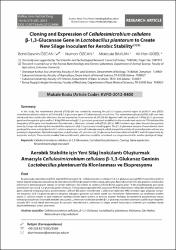| dc.contributor.author | Özcan, Bahri Devrim | |
| dc.contributor.author | Özcan, Numan | |
| dc.contributor.author | Baylan, Makbule | |
| dc.contributor.author | Güzel, Ali İrfan | |
| dc.date.accessioned | 2020-12-19T20:04:21Z | |
| dc.date.available | 2020-12-19T20:04:21Z | |
| dc.date.issued | 2013 | |
| dc.identifier.citation | Özcan, B.D., Özcan, N., Baylan, M., Güzel, A.İ., (2013).Cloning and Expression of Cellulosimicrobium cellulans beta-1,3-Glucanase Gene in Lactobacillus plantarum to Create New Silage Inoculant for Aerobic Stability.Kafkas Universitesi Veteriner Fakultesi Dergisi, 19(4), 575-581.https://doi.org/10.9775/kvfd.2012.8400 | |
| dc.identifier.issn | 1300-6045 | |
| dc.identifier.uri | https://doi.org/10.9775/kvfd.2012.8400 | |
| dc.identifier.uri | https://hdl.handle.net/11436/3318 | |
| dc.description | Guzel, Ali irfan/0000-0002-9720-5920; Ozcan, Bahri Devrim/0000-0002-9198-656X; BAYLAN, MAKBULE/0000-0003-0549-0662 | |
| dc.description.abstract | In this study, the recombinant plasmid pTE353-beta G was created by inserting the p353-2 cryptic plasmid region of pLP3537 into pTEG5 recombinant plasmid contains pUC18 and beta-1,3-glucanase gene of Cellulosimicrobium cellulans. the recombinant plasmid pTE353-beta G was then introduced into Lactobacillus plantarum by electroporation. Insert analysis of pTE353-beta G digested with SacI produced 1.9 kbp beta-1,3-glucanase gene band on agarose gel as well as 1.9 kbp DNA encoding beta-1,3-glucanase gene insert amplified on the recombinant vector via PCR indicated the integration of the gene into the plasmid. Recombinant L. plantarum colonies with pTE353-beta G on MRS-laminarin-agar plate showed clear positive zones by Congo-red staining that revealed the expression of beta-1,3-glucanase encoding gene. the beta-1,3-glucanase enzyme of recombinant strain produced the same activity band with C. cellulans enzyme in terms of molecular weight, which showed the activity of secreted protein without any proteolytic degradation. Optimal temperature and pH values of L. plantarum beta-1,3-glucanase have been determined 40 degrees C and 6.0 respectively, by enzymatic analysis. These results revealed that recombinant L. plantarum could be considered as a silage inoculant for aerobic spoilage of silage. | en_US |
| dc.language.iso | eng | en_US |
| dc.publisher | Kafkas Univ, Veteriner Fakultesi Dergisi | en_US |
| dc.rights | info:eu-repo/semantics/openAccess | en_US |
| dc.subject | Cellulosimicrobium cellulans | en_US |
| dc.subject | Beta-1,3-Glucanase | en_US |
| dc.subject | Lactobacillus plantarum | en_US |
| dc.subject | Cloning | en_US |
| dc.subject | Gene expression | en_US |
| dc.subject | Recombinant silage inoculant | en_US |
| dc.title | Cloning and expression of cellulosimicrobium cellulans beta-1,3-glucanase gene in lactobacillus plantarum to create new silage inoculant for aerobic stability | en_US |
| dc.type | article | en_US |
| dc.department | RTEÜ, Tıp Fakültesi, Temel Tıp Bilimleri Bölümü | en_US |
| dc.institutionauthor | Güzel, Ali İrfan | |
| dc.identifier.doi | 10.9775/kvfd.2012.8400 | |
| dc.identifier.volume | 19 | en_US |
| dc.identifier.issue | 4 | en_US |
| dc.identifier.startpage | 575 | en_US |
| dc.identifier.endpage | 581 | en_US |
| dc.snmz | oa | en_US |
| dc.relation.journal | Kafkas Universitesi Veteriner Fakultesi Dergisi | en_US |
| dc.relation.publicationcategory | Makale - Uluslararası Hakemli Dergi - Kurum Öğretim Elemanı | en_US |
| dc.identifier.wos | WOS:000321751900004 | |


















